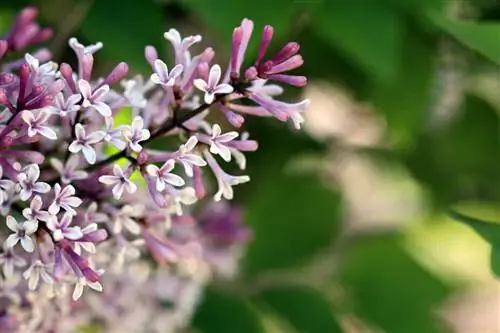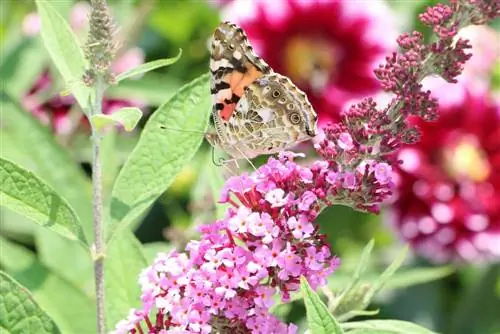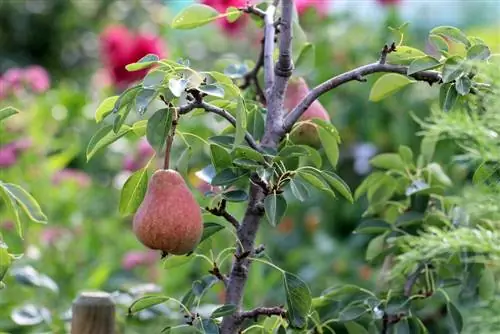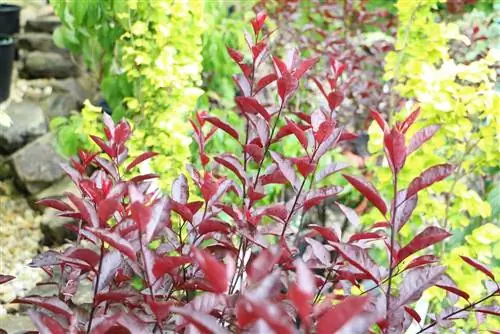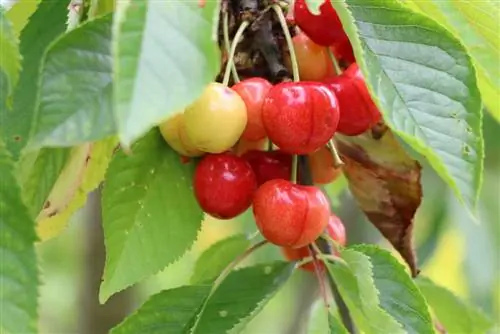- Author admin [email protected].
- Public 2023-12-17 03:39.
- Last modified 2025-01-24 12:45.
Despite its small size compared to its relatives, the dwarf lilac, which is native to China, impresses with its opulent blossoms, which are in no way inferior to the large lilac bushes.
Information on the dwarf lilac
- Growth height: 1 to 1.50 meters
- Growth width: 1 to 1.20 meters
- Growth habit: bushy
- Leaves: summer green
- Leaf shape: elliptical
- Leaf color: green
- Flowering period: May to June
- Flower shape: panicles
- Flower color: violet, pink, white
- Toxicity: No
Location Requirements
The dwarf lilac places few demands on its location, which is why it can be grown in almost any location. The location should still be based on the natural occurrence, the barren mountain slopes of China. The soil substrate should therefore have a permeable consistency in order to avoid waterlogging, which can lead to root rot. In addition, a sufficient supply of nutrients is essential to achieve a high flower density. The location you choose should also be in a sunny location to allow the dwarf lilac to display its full blooms. In terms of temperatures, the ornamental lilac is very heat-tolerant and therefore does not require any special heat protection.
Tip:
A water-impermeable soil can be loosened up by adding sand or drainage according to the needs of the dwarf lilac.
Planting partner
Due to its own lush blooms, the mini lilac should only be combined with plants that have their flowering phases earlier or later.
By making additional use of the different growth heights of the individual flowers, dense hedge arrangements can be created that have colorful and harmonious blooms throughout the year. Suitable plants for this would be:
- Weigela
- Scented jasmine (each early bloomer)
- hydrangea
- Hibiscus
- Ranunculus (each late bloomer)
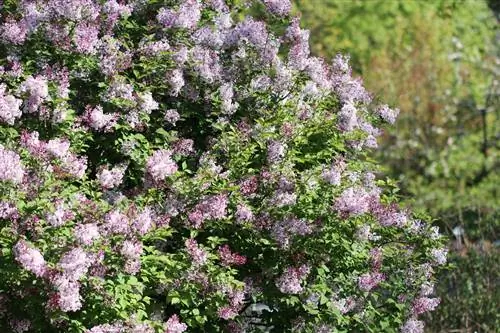
Planting
Since the dwarf lilac is a winter-hardy plant, it can generally be planted all year round. In practice, however, planting in the fall before the first frost has proven successful. The planting hole dug should be at least twice as large as the root ball. The hole is ideally filled with the addition of compost, which ensures an optimal supply of nutrients. Pouring should only be done sparingly and in several stages.
Note:
When planting several plants, a minimum distance of one meter should be maintained so as not to limit the space available for growth.
Propagation
The dwarf lilac can be propagated both from seeds and cuttings. In principle, both variants are extremely promising, so the choice can be made based on the requirements of the individual gardener. When propagating, it should also be taken into account that cuttings are clones of the mother plant, whereas seeds can deviate extremely from this.
Reproduction via seeds follows the following process:
- Harvesting the fruit heads after flowering
- Sow seeds in planting box and cover with soil
- Choose a shady and cool place for overwintering (cold germination)
- Moderate watering from spring to stimulate germination
- Pricking at a size of five centimeters
- Planting in autumn
In practice, propagation through cuttings is significantly more time-saving than through sowing. Propagation via cuttings occurs by cutting an unwoody shoot from the mother plant. The grown leaves are removed to support root growth before the shoot is placed in a container with potting soil.
Pouring routine
In principle, the mini lilac is both moisture and drought tolerant, so that short phases of excessive or low watering can be easily overcome. However, it is not very tolerant of extremes, so regular watering is important. When cultivating in a bucket, the amount of watering is generally slightly higher due to the limited amount of substrate, although the problem of waterlogging should not be neglected. The level of moisture can be determined quickly and easily by examining the leaves of the ornamental lilac and the soil substrate.
Note:
Without regular watering, the lilac will dry out even during the winter. It is therefore necessary to carry out light watering on frost-free days during this period too.
Fertilizer rules
The dwarf lilac prefers a balanced supply of nutrients, which requires regular fertilization. The easiest way to provide all the vital substances is to use a slow-release fertilizer that releases them consistently over several months. However, the fertilizer used should not contain any additional nitrogen components, as these inhibit flower formation.
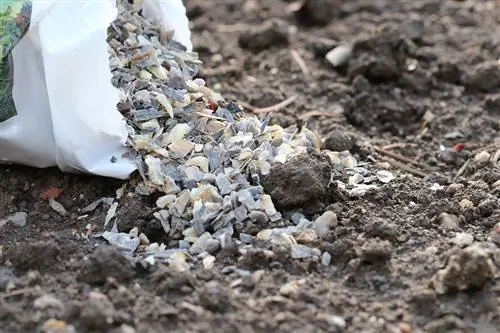
The following products are particularly suitable as fertilizers with a long-term effect:
- Horn shavings
- Compost
- Mulch
For plants planted in containers, similar to irrigation, higher and more frequent fertilizer applications are required. Due to the limited amount of soil, it is also recommended to use liquid fertilizer, which is added to the irrigation water.
Cut
The bushy shape of the ornamental lilac dictated by nature usually does not require any additional large-scale cutting of the plant. Nevertheless, it may be appropriate to regularly trim the plant into shape after flowering by specifically cutting dead and internally growing shoots. However, the time required to carry out the topiary cut is only very short, as the buds for next year's flowers are already formed in autumn.
- Decrease in withered flowers and leaves
- Exclusively shortening the excessively long growths
- Prune down to a pair of leaves or a bud
In practice, cutting between January and February has proven to be effective for thinning, although there should be no frost for several days afterwards. The optimal weather for uncomplicated healing of the incision sites should be cloudy, as excessive sunlight or rain prevent wound closure.
Even if the mini lilac is extremely easy to cut, a too radical thinning cut can lead to a one-year break in flowering because the branches have been removed along with the already formed buds. If possible, these shoots should remain untouched during the thinning cut.
- Primarily shorten frozen and broken branches
- Reduce branch length to a maximum of ten centimeters
- It is better to cut back only to the beginning of the he althy area
Wintering
The dwarf lilac is one of the hardy plants and can be overwintered both outdoors and in a pot. Depending on the location, it may still be necessary to set up additional protection mechanisms. Plants that are kept in pots should also be given additional protection, as the soil must urgently be prevented from freezing. In the worst case, this leads to the death of the roots and thus the entire plant.
Suitable materials for covering the base or planter are:
- Straw
- brushwood
- Mulch
- Styrofoam
- Wood
- Jute
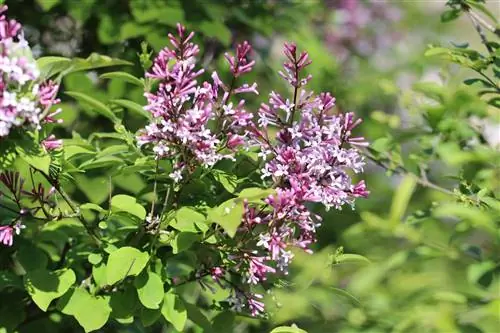
Care errors
The most common disease that dwarf lilacs can succumb to is root rot, which occurs due to excessive watering or a location that is too moist. The bacteria and fungi responsible for the disease prefer wet and cool underground locations to reproduce using spores. By depositing on the roots of the plant, they weaken growth and also deprive the plant of nutrients. Plants that have wilted and discolored leaves despite adequate watering should be checked for root rot.
- Excavation of the bush
- Radical cutting of the rotten root areas
- Careful cutting of the other root segments
- Air drying of the root ball (1 day)
- Transplantation to new location
- Withdrawal of water for two weeks
Aphids and mealybugs
The infestation by aphids and mealybugs mainly affects plants that have been exposed to a nutrient deficiency for a long time and therefore no longer have any self-protective effect due to their weak immune system. The lice feed on the vital plant sap, which they extract from the leaves, causing them to dry out and curl up. During suction, the mealy bugs secrete white webs that wrap themselves around the brown leaves.
In addition to the use of an insecticide, the use of the alternative treatment options listed below has also become established in practice.
- Cleaning with a powerful jet of water
- Spraying the plant with a mixture of milk and water (ratio 1: 8)
- Cleaning the leaves with soapy water and spirit (ratio 100: 1.5)
Lilac Moth
The lilac moth is a species-specific pest that predominantly attacks lilac bushes. The disease pattern includes brown leaves covered in leaf miners in spring, which rot and die over time. A specifically effective plant protection product against the lilac moth is not yet known. It is therefore advisable to carefully check the plants you are purchasing for possible pests when purchasing them. Generalized insecticides can be used, but they also harm beneficial insect species.
A more environmentally friendly disposal is shown as follows:
- Look for the centimeter-sized insects
- Removing insects from infected plants
- Generous pruning of the affected branches down to a branch length of ten centimeters

